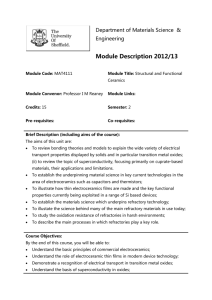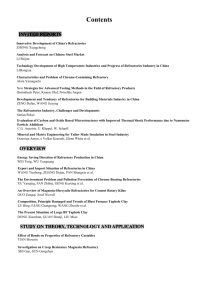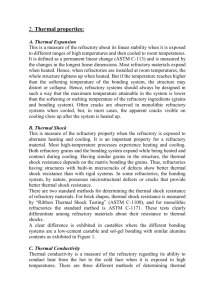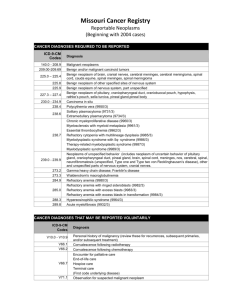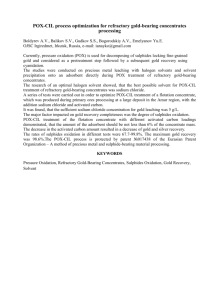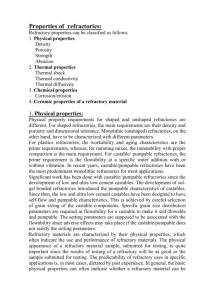Raw material challenges in refractory application
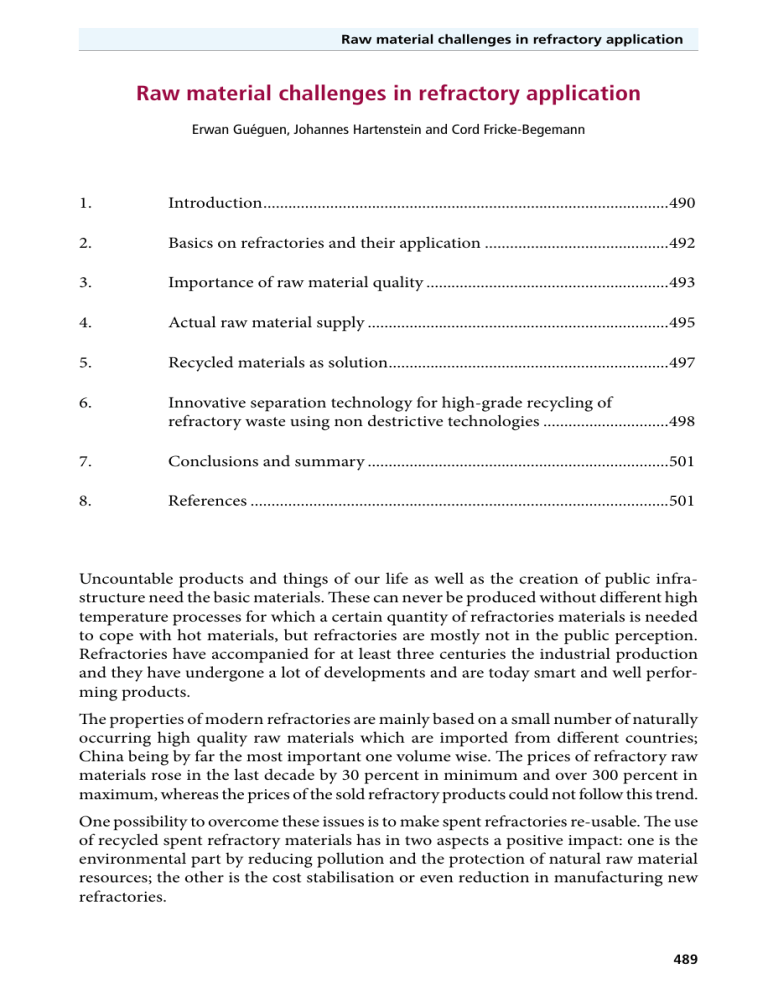
Raw material challenges in refractory application
Raw material challenges in refractory application
Erwan Guéguen, Johannes Hartenstein and Cord Fricke-Begemann
3.
4.
1. Introduction .................................................................................................490
2. Basics on refractories and their application ............................................492
Importance of raw material quality ..........................................................493
Actual raw material supply ........................................................................495
5.
6.
Recycled materials as solution ...................................................................497
Innovative separation technology for high-grade recycling of refractory waste using non destrictive technologies ..............................498
7. Conclusions and summary ........................................................................501
8. References ....................................................................................................501
Uncountable products and things of our life as well as the creation of public infrastructure need the basic materials. These can never be produced without different high temperature processes for which a certain quantity of refractories materials is needed to cope with hot materials, but refractories are mostly not in the public perception.
Refractories have accompanied for at least three centuries the industrial production and they have undergone a lot of developments and are today smart and well performing products.
The properties of modern refractories are mainly based on a small number of naturally occurring high quality raw materials which are imported from different countries;
China being by far the most important one volume wise. The prices of refractory raw materials rose in the last decade by 30 percent in minimum and over 300 percent in maximum, whereas the prices of the sold refractory products could not follow this trend.
One possibility to overcome these issues is to make spent refractories re-usable. The use of recycled spent refractory materials has in two aspects a positive impact: one is the environmental part by reducing pollution and the protection of natural raw material resources; the other is the cost stabilisation or even reduction in manufacturing new refractories.
489
Erwan Guéguen, Johannes Hartenstein, Cord Fricke-Begemann
The recycling of refractories needs sophisticated processes to separate the used refractory itself from adhering metal, slags and altered parts; further a clear material detection which allows a separation into different material classes is needed. The first step is currently well practised in several industries. Mastering the second step by the introduction of a non-destructive laser based analysing and sorting system seems a promising route to convert undefined refractories into homogeneous re-usable refractories. First practical tests have shown the ability of such a system to distinguish different refractory material classes based on the analyses of three major elements.
1. Introduction
Refractory materials are without exception solids which can withstand high temperatures. They should keep their mechanical function, even in contact with corrosive liquids and gases, for a required period of time. Refractory materials are called as refractory when their melting point is higher than 1500 °C and as highly refractory when 1700 °C is exceeded. Usually they do not possess a distinct melting point; they soften and melt in a specific and usually narrow temperature range. The end point of melting has not much significance; the start and the interval for softening are much more important for the application of the individual refractory material (Figure 1).
Refractory materials are required for a lot of industrial melting processes such as in the production of steel, aluminium and copper; but also for the production of nonmetallic materials such as burnt lime, cement clinker, glass and coke; and finally for
°C
2,000 melt
1,500
490
1,000
SiO
2
50 % mass /mass
Al
2
O
3
Figure 1:
Phase diagram SiO – Al showing melting intervals
2
O
3
Raw material challenges in refractory application
Raw Material Formula Reaction Melting Main Sources
Point
Silica SiO
2 acid
Fireclay SiO
2
+ Al
2
O
3 acid
1,720 °C
1,100 °C
Global
Global
Aluminia Selicate SiO
2
+ Al
2
O
3 acid
Alumina Al
2
O
3
1,350 °C China neutral 2,050 °C synthetic neutral 2,715 °C South Africa Zirkonia ZrO
2
Zircon ZrSiO
4
Chromite FeCr
2
O
4 neutral neutral
1,775 °C Australia
2,265 °C South Africa
Spinel MgAl
2
O
4 neutral 2,135 °C synthetic
Magnesia MgO basic 2,820 °C China
Sinter Dolomite CaO + MgO basic
Graphite C neutral
2,370 °C Europe / Global
3,600 °C China
Table 1:
Important refractory raw materials the production of refractories (e.g. magnesia, alumina, doloma, chamotte or synthetic spinel) themselves.
Refractory materials have to protect the vessel and must support the production process and last but not least keep the required heat.
Refractory materials are differentiated product groups:
– shaped products, also called bricks,
– unshaped products, also called monolithics,
– functional products and
– heat-insulating products.
The shaped products are further differentiated by the type of the used bonding:
– ceramic bonded bricks (carbon free) or fired bricks,
– carbon bonded bricks, or tempered bricks.
Refractories are mainly based on six oxides and some of their minerals between them:
SiO
2
, Al
2
O
3
, MgO, CaO, Cr
2
O
3
and ZrO
2
(Table 1). Very often carbon in different forms is used as addition. Occasionally borides and nitrides for special applications as well as some base metals as antioxidant for the carbon are used (Figure 2).
Refractories are classified according to their chemical reaction behaviour in acidic, neutral and basic products. This is important for the correct application and compatibility with the operation process in which they take part. Refractories face not only the product processed; they have to cope also with slags and dusts or with corrosive vapours which occur also in the same process. The best overall adaption of the refractory products to the different process steps will result in reduced wear / corrosion or better performance.
491
Erwan Guéguen, Johannes Hartenstein, Cord Fricke-Begemann
MgO, Doloma, Alumina, ...
or combination
Carbon bonded bricks
Resin, Pitch, Oil, …
Oxides
Binders Refractory Carbon Sources
Fired Bricks temporary
Binder, Phosphate, Clay...
Additives
Antioxidant for instance
Al/Si/Al-Mg/B
4
C/CaB
6
Graphite,
Carbon Black
Micropowders,…
Figure 2:
General scheme for refractory product conception
2. Basics on refractories and their application
Based on the quantities of used refractories their main applications are steel production and cement production. In 2013 1607 Mt (million metric tonnes) crude steel and 3780 Mt of cement were produced. Both industries used accumulated 67 percent of the global refractory consumption of about 27.6 Mt. The remaining 33 percent of refractory materials are used in the non-ferrous (5 percent), glass (5 percent), foundry (2.3 percent), ceramic (2.2 percent), petro-chemical (1.6 percent), incineration & power generation (1.6 percent) and other industries.
When inspecting the actual refractory demand in different regions in detail one can see that PR China is today (2012) with 55 percent by far the largest consumer, followed by
Asia & Oceania using 13 percent, the European Community with 8 percent and North
America with 8 percent. The residual other regions such as Japan, Middle East, the CI
Specific Consumption crude steel kg/t
60
50
40
30
20
10
0
1960 1965 1970 1975 1980 1985
Sourrce: Statistisches Jahrbuch der Stahlindustrie
1990 1995 2000 2005 2010
Figure 3: Development of specific refractories consumption
Source: Statisches Jahrbuch der Stahlindustie
492
Raw material challenges in refractory application
States, Africa and Latin America use together 16 percent. Years ago Europe, Japan and
North America accounted for more than 50 percent! The evolution of different heavy industry cores in Asia is the driving factor and will progress further.
The specific refractory consumptions in the steel industry have been decreasing since the 1950’s. The steel industry had a specific consumption of around 50 kg / t of crude steel. Over the past 65 years the grades have switched from chamotte bricks with high porosity to highly sophisticated engineered materials. The consumption was reduced to around 10 kg / t by several major improvements in the primary steel production process, such as the replacement of the so-called Thomas-Process by Basic-Oxygen-
Furnaces and of the Open-Hearth-Furnaces by Electric-Arc-Furnaces. The secondary step in steelmaking changed from bloom casting to continuous casting machines which reduced the demand for refractories also drastically (Figure 3).
In the cement industry one can see over the last six decades the same trend of decreasing specific refractory consumptions. Starting in the 1950’s with plus 2 kg / t
(refractories / cement clinker) we are today in average at 0.9 kg / t. In most modern kilns already less than 0.2 kg / t is achieved. The driving force here was the changes from the wet process for clinkering to the dry process; followed by the introduction of preheating towers and precalciners.
Taking the specific refractory consumption of the 1950’s and the industrial production of today the refractory demand would calculate to approx. 150 Mt instead of 27.6 Mt.
This comparison shows the real progress in development, quality and performance of products from the hidden refractory industry. On the other side it shows also the need for the shrinking of the refractory industry resulting in the merging of former competitors to new global acting enterprises.
3. Importance of raw material quality
Well selected raw materials are the crucial part for the development and the production of satisfactory refractory products. The raw material properties influence directly and indirectly important refractory properties.
Raw materials have to match at least six different properties for the production of high performance refractory products:
– sufficient initial grain size;
– density / porosity;
– main mineral / oxide share;
– limits in reducible oxides and / or fluxing oxides;
– molar balance of important oxides;
– crystal size of the main mineral / oxide .
Magnesia sinter for example has to have high density plus 3.30
g / cm³, an MgO share plus 97.5 percent, an iron oxide share less 0.5 percent, a molar lime silica ratio of 3.0, an MgO crystal size plus 120µm.
493
Erwan Guéguen, Johannes Hartenstein, Cord Fricke-Begemann
Linear Dilatation
%
2.0
1.5
1.0
0.5
0
0 500 1,000
Temperature °C
Figure 4: Thermal expansions of different refractory minerals
1,500
Thermal Conductivity
W/m * K
10
8
6
4
2
0
0 500 1,000
Temperature °C
Figure 5: Thermal conductivities of different refractory minerals
494
1,500
Raw material challenges in refractory application
High-grade refractory bauxite has to have a density plus 3.35 g / cm³, an alumina share of 86 to 88 percent, a titania share less than 3 percent, an iron oxide share less than 1.5 percent, and a low alkali share.
Graphite has to have a high packing density; a fixed carbon content of plus 96 percent; ash content less than 3 percent, low sulphur content; a sufficient flake size plus 100µm.
The properties of the final refractory products such as thermal expansion, heat capacity, thermal conductivity and refractoriness are solely influenced by the used raw materials / minerals (Figure 4 and Figure 5).
The density, porosity, permeability, crushing strength, modulus of rupture and elasticity and thermal shock resistance are mainly determined by the raw materials and the production process of the refractories themselves. Most important is the packing or green density achieved by an appropriate grain size distribution and a sophisticated moulding of the individual article or brick. The subsequent firing or tempering gives finally the desired properties.
The wear and corrosion resistance of the refractory products depend on both the raw materials and the conditions in use; like steel grades and slag types in steel production units; on kiln types and local atmospheres in the cement manufacturing.
The highest wear rates are often observed at the points with the highest temperatures and high thermal loads. Localised wear can be seen in different vessels at the triple junction of solid refractory, molten slag and hot ambient gas atmosphere which is triggered by the so-called Marangoni Convection. In the zones were the refractories are in contact with metal or slag only very limited wear is to observe. A lining for a vessel must have zones of different dedicated refractory grades for each different wear pattern.
4. Actual raw material supply
In 2012 in Europe around 51 percent of the refractory production of about 1.73 Mt were basic bricks mainly magnesia and around 22 percent high alumina bricks which contain a high share of refractory bauxite and tabular alumina. Additionally graphite was used for basic and high alumina bricks to improve their thermal shock resistance and rejection of molten metal. The situation for the supply for these three raw materials is shown in detail below.
Magnesia:
Large deposits of magnesite (MgCO
3
) are the basis for sintered or fused magnesia.
Sintered magnesia (MgO) is usually fired in shaft or rotary kilns to remove the carbonate and sintering it to low porosity; for calcination and sintering often separate furnaces / kilns are used. Fused magnesia is manufactured by electrical fusion either directly from the carbonate or from the calcined magnesia. In 2012 worldwide 8.5 Mt of magnesia (MgO) were produced; 4.15 Mt = 49 percent in PR China (Figure 6).
Other production countries were Russia (12 percent), Turkey (6 percent), Austria (5 percent) and Brazil (5 percent). Deposits and reserves of MgCO
3
are virtually endless, about 13.5 billion tonnes.
495
Erwan Guéguen, Johannes Hartenstein, Cord Fricke-Begemann
Natural Magnesite Refractory Grade Bauxite Flake Graphite
Figure 6: Sources of important refractory raw minerals
Source: PRE Fédération Européene des Fabriacnts des ProduitsRefractairies
Bauxite:
Sintered (refractory) bauxite and tabular alumina are both based on the natural mineral bauxite (in majority different Al- Fe-Hydrates). In the case of refractory bauxite the raw bauxite is processed and fired at temperatures above 1500 °C. In the case of sintered
(tabular) alumina the raw bauxite is chemically leached in the Bayer-Process where iron oxide and titania are removed, the resulting pure alumina hydroxide is first calcined to alumina and then fired at temperatures above 1800 °C. In 2011 around 5.2 Mt of refractory grade bauxite was produced worldwide; 77 percent in PR China; followed by Russia (9 percent), India (7 percent), Guyana (6 percent) and Brazil (1 percent).
Suitable deposits for manufacturing refractory bauxite grades are limited worldwide.
Chinese supply still dominates international markets in particular after the Guyana bauxite mining operations were taken over by Chinese owners (Figure 6). Substitution of bauxite is possible in minor extent by natural andalusite and synthetic mullite.
Graphite:
Graphite occurs as natural mineral in different metamorphic rocks and needs a beneficiation by milling and flotation before it can be used as flake graphite with plus
95 percent carbon in refractory products. In 2012 worldwide 1.10 Mt (million metric tonnes) of graphite were produced; 0.75 Mt = 68 percent came from PR China (Figure
6). The next largest producers were India (13.5 percent) and Brazil (6.8 percent). Very limited substitution can be made by other carbon sources and synthetic graphite.
496
Raw material challenges in refractory application
5. Recycled materials as solution
As described above, the raw materials are of primary importance for the refractory industry with availability of quality materials and security of supply as main topics [2]:
– raw materials accounts for about 40 to 50 percent of the refractory costs
– raw materials have the major influence on the quality of the finished products
– refractory industry depends heavily on raw materials imports coming mainly from China
– raw material prices have increased significantly within the last years
The prices of refractory raw materials increase 30 percent to 300 percent over the last decade, whereas the prices of the sold refractory products could not follow this trend.
In particular the prices for dead burned and fused magnesia increased by 185 percent; the prices for bauxite by 295 percent due to new export regulations of the government of PR China (Figure 7).
Closing the material loop of refractories, the use of spent refractories for the production of new refractory products will reduce the total cost of raw materials and will make the production of refractories in Europe more competitive. For society as a whole, scarcity of primary raw materials and environmental concerns drive the need for sustainable waste treatment and working towards closing material cycles.
The refractory linings in steel production units and as well in cement kilns are never used in their complete quantities. There are always minimum residual lining thicknesses needed, without them the heat protection of the steel shells would be lost. raw material prices
%
350
300
250
200
150
100
50
0
2000 2001 2002 2003 2004 2005 2006 2007 2008 2009 2010
Bauxite FM
Tabular Alumina
DBM Andalusite
Figure 7:
Development of refractory raw minerals prices
Source: PRE Fédération Européene des
Fabricants des ProduitsRefractairies
497
Erwan Guéguen, Johannes Hartenstein, Cord Fricke-Begemann
In ladles approx. 25 percent of the initial working lining is left, in electric arc furnaces
30 percent and in basic oxygen furnaces around 35 percent. In cement kilns approx.
25 percent of the refractories are left but actually not recycled in Europe and most of the other countries.
The residual refractories are only partially infiltrated by slags and metal, 80 to 90 percent of the residual bricks are not affected. These materials are recycled in steel plants since the 1990’s according to EC regulations aiming for environmental protection by reducing the quantities of dump materials and land-fill. It is to consider that these residual refractories are not only residues ; they have a commercial value, in particular when they are reprocessed, upgraded and purified. For example residual magnesia carbon bricks from the converters are recycled and re-used for manufacturing magnesia carbon bricks for ladle slag lines in the same steel plant.
From the available refractory materials at least seven different refractory products are usually recycled in remarkable quantities: fired chamotte, fired andalusite, fired bauxite, fired magnesia and fired dolomite. Carbon bonded refractories are also recycled: magnesia-carbon with and without antioxidants, in these grades not only the oxide minerals are important, the carbon share of about 5 to 15 percent is also appreciated.
Chamotte and andalusite usually is re-used in unshaped refractory mixes; the recycled doloma bricks are used as slag conditioners.
Main challenge in the recycling process is the proper separation of the initial waste material ensuring its re-usage in significant quantities. The purity of spent refractories is of vital importance in re-using them in high quality refractories. The presence of unwanted impurities in the recycled refractory materials would decrease the durability of the new finished products, or would limit the amount of recycled material that can be admixed to the primary raw material.
Efficient separation of the different refractory materials based on their chemical composition combined with an efficient removal of unwanted impurities is therefore essential to achieve high-grade recycling and re-use of spent refractories.
6. Innovative separation technology for high-grade recycling of refractory waste using non destrictive technologies
In 2013 the European Commission has approved to fund new research projects shaping a more resource efficient economy in Europe. The projects, that involve collaboration from research organisations and private companies, aim at tackling the challenges of recycling waste materials in order to avoid land-fill and environmental pollution and last but not least to save money.
RefraSort (innovative technologies for high-grade recycling refractory waste using non destructive technology) is one of the projects funded by the EC. The project is executed by a consortium of seven partners from three European countries. The objective of RefraSort is to develop an automated sorting and separation technology for used
498
Raw material challenges in refractory application
3D laser direct analysis sorting
Figure 8:
1 2
3 4
Schematic of a sensor-based sorting system using laser direct analysis for material identification refractory material without comminution which provides pure high-quality secondary raw materials adapted to the needs of the refractory production, thereby maximizing its valorisation potential.
A key technology to enable automated separation is the identification of individual pieces of spent refractories. Direct laser analysis promises to fulfil the sensor requirements for industrial operation in a separation plant. Figure 8 depicts the principle of a laser-based sorting system. Material pieces are singularized and fed onto a continuously moving conveyor where they are inspected. Based on the findings, the pieces are afterwards directed into specific material fractions, for example by using air jets at the end of the conveyor.
In the process shown the pieces are first visually inspected with the aid of a laser line projection to determine position, size and geometry of each object. In a following step, their chemical composition is determined by laser direct analysis. Using an intense laser pulse a small amount of material from the object is vaporised and excited to induce element specific optical emissions, which are spectroscopically analysed. This measurement technique is known as laser-induced breakdown spectroscopy (LIBS) and suited to reveal the multi-elemental composition of arbitrary materials fast, sensitive and contact-free. LIBS has been used for industrial process control for over a decade
[1], where it is employed for, e.g., monitoring metal and raw material composition and the control of by-products such as slags. For recycling purposes LIBS has been demonstrated to be the first sensing technique able to distinguish individual wrought aluminium alloys.
For the sorting of a used refractories, besides the issues of mechanical handling, also the laser-based material identification has to solve a series of specific challenges which arise, for example, from the broad variety of refractory materials used, the internal heterogeneity of the material and the possible surface contaminations by residues from their previous use. These will be approached by spatial control of the laser excitation and laser-induced surface cleaning as an integrated process. The laser excitation on a refractory brick is imaged in Figure 9.
499
Erwan Guéguen, Johannes Hartenstein, Cord Fricke-Begemann
Figure 9:
Laser-induced plasma on a piece of used refractory
The ability of LIBS to distinguish the main types of refractory materials is shown by the preliminary results given in Figure 10. Eight different materials were studied and the intensities of selected spectroscopic features originating from the elements Ca,
Mg and Si are plotted. The viewgraph allows distinguishing directly between type A material which is based on MgO, type B containing both MgO and CaO, and type C which is produced from mainly SiO and Al
2 2
O
3
. Additionally, differences within those main classes are also observed between the different formulations. The statistical significance of the separation is indicated by the 1-sigma error bars of repeated measurements each taking less than a second. Further elements including Al and C are also observed simultaneously and incorporating them in the data evaluation is expected to allow identifying the composition of the sub-classes and providing a reliable basis to sort refractory material with high purity and enable improved high-grade recycling.
0.6
0.4
normalised signal intensity
1.0
0.8
0.2
0.0
A1
Ca
A2
Mg
A3
Si
B1 B2 material
C1 C2 C3
Figure 10:
Preliminary results of laser spectroscopic signals obtained for selected elements to distinguish the main types of refractory ma- terials
500
Raw material challenges in refractory application
7. Conclusions and summary
The re-use of spent refractories will become mandatory in future in the refractory industry due to environmental and commercial reasons.
The introduction of the laser based analysing and integrated sorting system currently developed in the project RefraSort will allow precise discrimination of the main refractory material classes and sub-classes from a stream of undefined used refractory products.
This novel technology will enable the refractory industry to re-use a larger quantity of spent materials than is the case today and to counterbalance the commercial impacts of highly volatile raw material prices.
8. References
[1] Noll, R. et al.: Laser-induced breakdown spectroscopy expands into industrial applications.
Spectrochimica Acta Part B, 93 (2014), 41–51.
[2] Schmidt-Whitley, R.: The European refractory industry faces new challenges. 50 th Congress of the Spanish Ceramic and Glass Society, 27-29 October 2010, PRE Conference Paper
Acknowledgements
The RefraSort project has received funding from the European Union’s Seventh Programme for research, technological development and demonstration under grant agreement No 603809.
501


